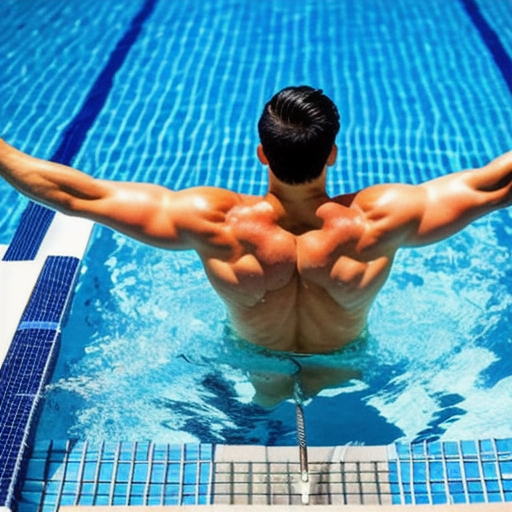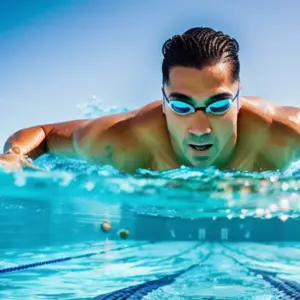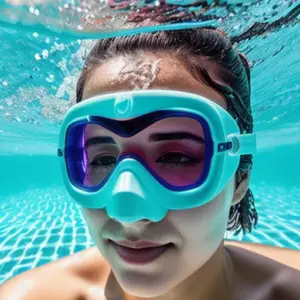Diving headfirst into the refreshing blue oasis, feeling the cool water envelop your body, and effortlessly gliding across the surface, swimming has often been touted as one of the best ways to unwind, exercise, and connect with nature. Have you ever paused mid-stroke to wonder at the sheer power and intricate finesse that this full-body workout demands of our muscles? Giving you the drive, the buoyancy, and the mastery to navigate different swimming strokes, the muscles involved in swimming play a harmonious symphony that can leave even the most trained athletes in awe. In this blog post, we will sow the seeds of curiosity about the complex and intriguing world of muscles, and unearth the secrets of how they come together to create the effortless beauty that is swimming. Dive in with us as we explore the ripple effect of muscle engagement, and help you understand the physical artistry of human bodies interacting with water.
Swimming engages a wide range of muscles
Swimming is a fantastic full-body workout that engages a wide range of muscles, providing both cardiovascular and strength benefits. The muscles used in swimming largely depend on the stroke being performed, with each of the four major strokes – breaststroke, freestyle, backstroke, and butterfly – targeting various muscle groups.
Breaststroke primarily works the upper body muscles, including the latissimus dorsi (back muscles), pectoralis major (chest muscles), biceps, brachialis, brachioradialis, and the deltoids (shoulder muscles). Moreover, the leg muscles used during breaststroke include the gluteus maximus (butt muscle), quadriceps (thigh muscles), and the gastrocnemius and soleus (calf muscles).
Freestyle, or front crawl, primarily targets muscles such as the triceps, biceps, quadriceps, and hamstrings. In addition, the core is engaged throughout this stroke, making it a great way to tone the abdominals and obliques.
Backstroke uses many of the same muscles as freestyle but also activates the deltoids (shoulders) and latissimus dorsi (large back muscles) due to the reverse arm movement. The flutter kick used in backstroke engages the glutes, quads, hamstrings, and anterior tibialis (shin muscles) in the legs.
Butterfly is a physically demanding stroke that utilizes a wide variety of muscles, including the quads, pecs, hamstrings, deltoids, and lats. This stroke requires the fullest whole-body muscle engagement out of the four strokes and the most arm muscle engagement per stroke cycle.
In summary, swimming is an excellent full-body workout that targets numerous muscle groups, making it an ideal choice for both fitness and relaxation.

Low risk of injury and numerous benefits
Swimming is a popular full-body workout that engages almost all muscle groups, with a low risk of injury and numerous benefits. The sport is performed in water, which gives it a natural low-impact advantage as the buoyant force counteracts the effects of gravity, reducing the strain on joints and muscles. As a result, swimmers are less likely to experience injuries that are typically associated with high-impact activities like running or weightlifting.
Some of the key muscles used in swimming include core abdominal and lower back muscles, which help in maintaining a streamlined position in the water, as well as deltoid and shoulder muscles that are crucial for an efficient stroke. Additionally, forearm muscles, upper back muscles, glutes, hamstring and related muscles aid propulsion and balance in the water, allowing swimmers to move efficiently and effectively.
Not only does swimming help build and tone muscles in a low-risk environment, but it also offers several health benefits, such as improved cardiovascular fitness, increased lung capacity, and better endurance. Moreover, swimming has a positive effect on mental health, as it is known to be a relaxing and stress-relieving activity. Swimmers also tend to have better posture due to the strength and stability gained from engaging their back and shoulder muscles while swimming.
In conclusion, swimming is an excellent low-impact sport that provides a full-body workout, encourages muscle development, and offers numerous health benefits.
Core abdominal and lower back muscles are key in reducing drag
Swimming is an excellent full-body workout that engages numerous muscles, providing a wide range of benefits. Among the primary muscles involved in swimming are the core abdominal and lower back muscles that play a crucial role in stabilizing the body and reducing drag during each stroke, making the swimmer more efficient in the water.
Deltoid and shoulder muscles crucial for proper hand entry and reach
One of the essential muscle groups used in swimming is the deltoid and shoulder muscles, which play a crucial role in the overall swimming experience and technique. These muscles, located in the upper body, help ensure proper hand entry in the water and allow for a more extended reach during each stroke. As a result, swimmers can cover more distance with each movement, making their swimming motion more efficient and powerful.
The deltoid muscles, also known as the shoulder muscles, are responsible for the rotation and stabilization of the arm during swimming. They help move the arm forward and backward, providing the necessary force required for each stroke. In addition to the deltoids, the other shoulder muscles, such as the trapezius, teres major, and rhomboids, also contribute to the effectiveness of each stroke. When these muscles work together in harmony, they can significantly improve a swimmer’s performance and overall technique.
In addition to influencing the technique and power behind each stroke, strong deltoid and shoulder muscles also contribute to injury prevention for swimmers. The nature of swimming, characterized by repetitive arm motions, can often lead to strain and stress on the shoulder girdle and surrounding muscles. Improved muscle strength and coordination can help protect against injuries commonly associated with swimming, such as shoulder impingement or rotator cuff tears.
Moreover, these muscle groups play a crucial role in maintaining good posture both in and out of the water. Strong deltoid and shoulder muscles promote proper positioning and body alignment while swimming, ensuring fluidity in movement and less drag, ultimately enhancing overall performance within the sport.
Forearm muscles worked when pulling in water
When swimming, one of the key muscle groups engaged is the forearm muscles, which play a crucial role in providing propulsion and stability during various swimming strokes. As a swimmer pulls their arms through the water, they rely on the strength and contraction of these muscles to generate force and momentum. This action not only helps to propel the body forward but also contributes to overall upper body strength and muscle tone.
There are several primary forearm muscles involved in swimming – the flexor carpi ulnaris, flexor carpi radialis, flexor digitorum superficialis, and the pronator teres. These muscles work in conjunction with each other and with other muscle groups in the arms, shoulders, and back to enable smooth, powerful and efficient strokes.
Swimming is a low-impact, full-body exercise that provides numerous benefits, including increased muscular strength and endurance, enhanced flexibility, and improved cardiovascular fitness. By engaging the forearm muscles during swimming, individuals can develop greater overall upper body strength, better stroke technique, and more efficient swimming performance.
In conclusion, the forearm muscles are vital components in the mechanics of swimming. They contribute to propelling the body through the water, improving stroke technique, and enhancing upper body muscular strength. With regular swimming, these muscles become stronger and more flexible, resulting in improved swimming performance and a host of additional health benefits. So next time you dive in, take a moment to appreciate the work your forearms are doing to help you glide through the water.
6. Glutes and hamstring muscles aid in propulsion
Swimming is a fantastic low-impact sport that engages and develops various muscle groups in the body, providing numerous benefits. One of the essential muscles used in swimming is the glutes and hamstring muscles, which aid in propulsion.
Located at the back of our thighs, the hamstring muscles consist of three muscles: biceps femoris, semitendinosus, and semimembranosus. On the other hand, the glutes consist of three muscles as well: gluteus maximus, gluteus medius, and gluteus minimus. Both hamstring and glutes muscles play a crucial role in maintaining balance in the water, ensuring a streamlined position and propelling the body forward more efficiently.
With each swimming stroke, these muscles are engaged in various ways. For example, in freestyle and backstroke, they enable a compact and steady kick, helping the swimmer maintain proper body alignment. The butterfly stroke further utilizes these muscles in performing a powerful dolphin kick. Similarly, in the breaststroke, these muscles contribute to a strong kick, allowing for better propulsion in the water.
Increased engagement of glutes and hamstring muscles results in improved strength, flexibility, and endurance. This not only enhances swimming performance but also benefits daily activities such as walking, going up stairs, and lifting. Furthermore, as swimming helps in developing core stability and better posture, these muscles contribute to a healthier and more balanced life outside the pool. Overall, working on the glutes and hamstring muscles through swimming provides both physical and psychological benefits for individuals of all ages and fitness levels.
Breaststroke works upper body muscles and leg muscles
Breaststroke is an excellent swimming style that engages a wide range of muscles in both the upper and lower body, ensuring a comprehensive workout. This versatile stroke combines rhythmic movements from the arms and legs, effectively targeting multiple muscle groups, and providing swimmers with a range of physical benefits.
One of the primary muscle groups used in breaststroke is the upper body muscles. As swimmers perform the Y-shaped arm movement, they engage the latissimus dorsi (back muscles), pectoralis major (chest muscles), biceps, brachialis, brachioradialis, and the deltoids (shoulder muscles). Additionally, the in-sweep and out-sweep arm motion helps to build strength in the shoulders and back, contributing to a stronger upper body overall.
Breaststroke also heavily works the lower body muscles, especially during the powerful frog kick that propels the body through the water. This movement activates the glutes (butt muscles), quadriceps (thigh muscles), hamstrings, and even the gastrocnemius and soleus (calf muscles). These leg muscles are essential in providing the majority of the propulsion necessary for a successful breaststroke.
Lastly, the breaststroke is also beneficial for strengthening the core muscles. As a short-axis stroke, it requires rotation and bending at the hips, which in turn engages the abdominals and obliques. This helps to stabilize the body and improve overall endurance, making breaststroke a well-rounded and effective exercise for swimmers of all skill levels.
In summary, breaststroke is an excellent full-body workout that engages the upper body, lower body, and core muscles, ensuring a comprehensive and effective swimming experience.
Freestyle primarily activates triceps, biceps, quadriceps, and hamstrings
Freestyle swimming is an excellent full-body workout that focuses on strengthening and toning various muscle groups. The primary muscles activated during freestyle swimming are the triceps, biceps, quadriceps, and hamstrings. Alongside these major muscle groups, freestyle swimming also engages the core abdominal and lower back muscles, which help in maintaining balance and a streamlined position in the water. The deltoid and shoulder muscles are responsible for a proper hand entry and longer reach in the water.
During the freestyle stroke, the muscles work together to propel the swimmer forward. The triceps and biceps are essential for efficient arm movement, while the quadriceps and hamstrings help in maintaining a steady, coordinated kick. Additionally, the hip flexors and thenars (hand muscles) are also involved in executing an effective freestyle stroke.
Freestyle swimming offers numerous benefits, such as improved posture, increased lung capacity, muscle endurance, and overall cardiovascular health. The low-impact nature of swimming also reduces the risk of injury and serves as a great form of exercise for people of all ages and fitness levels.
In summary, freestyle swimming is a highly effective workout that primarily targets the triceps, biceps, quadriceps, and hamstrings, while also engaging several other muscle groups. It offers a wide range of health benefits and is suitable for various fitness goals.
Backstroke uses similar muscles to freestyle with added latissimus dorsi activation
Swimming is a popular form of exercise that provides numerous health benefits, ranging from improved cardiovascular fitness to increased muscle strength and endurance. Each swimming stroke utilizes different muscle groups, with the backstroke, for example, activating similar muscles as the freestyle stroke, but with added engagement of the latissimus dorsi (the large muscles extending across the back).
The backstroke is a unique swimming style as it requires the swimmer to be in a supine position, relying on a strong upper body and core to propel themselves through the water. As with the freestyle stroke, the backstroke employs a wide range of muscle groups, including triceps, biceps, quadriceps, and hamstrings. The core muscles, such as the abdominals and obliques, are engaged throughout the stroke to maintain stability and streamline the body.
What sets the backstroke apart from the freestyle is the increased activation of the latissimus dorsi and deltoids (shoulder muscles). This added muscle activation is due to the reversed arm movement, working in synergy with a flutter kick to power the swimmer through the water. Therefore, not only does the backstroke build muscle strength and endurance, but it also helps to counter some of the muscle imbalances that may arise from focusing solely on freestyle swimming.
In summary, the backstroke is an excellent workout for swimmers looking to strengthen their upper body and core muscles, while also providing a complementary training method for individuals predominantly swimming the freestyle stroke.




